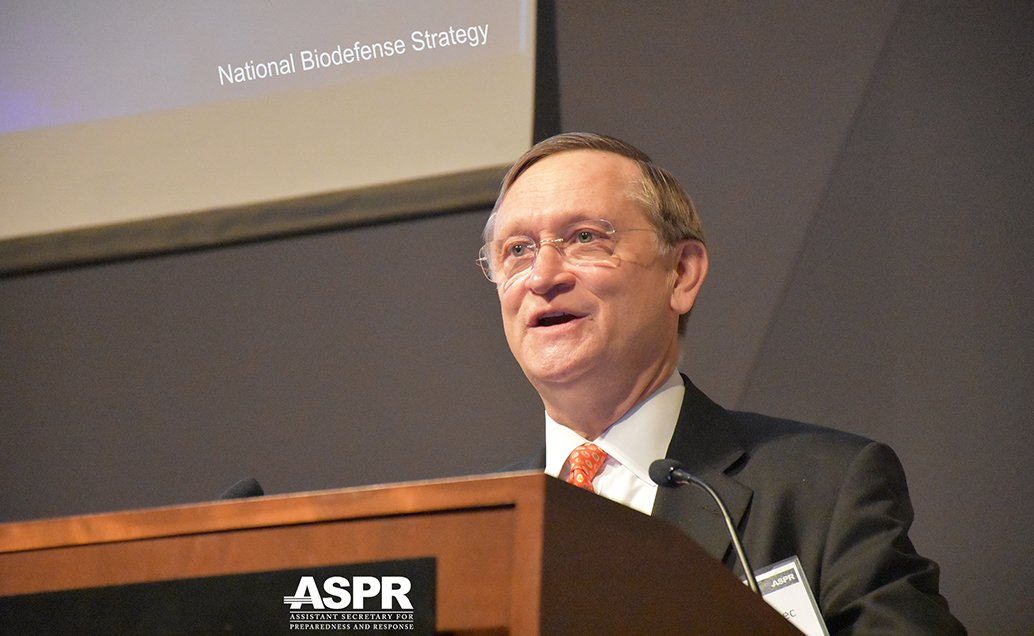
As the U.S. government seeks to build its National Biodefense Strategy, more than 200 heavy hitters from federal, state and local agencies, national stakeholder organizations, academia and the private sector informed its future implementation during the April 17 Biodefense Summit held in Washington, D.C.
Robert Kadlec, the Assistant Secretary for Preparedness and Response (ASPR) in the U.S. Department of Health and Human Services (HHS), last month announced the public summit to engage the biodefense stakeholder community on how to counter biological threats, reduce risk, and prevent, prepare for, respond to, and recover from biological incidents.
On Wednesday, Kadlec reminded summit participants and webinar attendees that the 21st century threats facing America are “real and serious.”
“That’s why biodefense is a national security priority,” he said. “We need to protect all Americans.”
The National Biodefense Strategy “addresses all the possibilities” around biological threats, Kadlec said, and it ensures medical countermeasures are “at the ready” should the United States ever need to access them.
“Biologic threats of a man-made, accidental or of a naturally occurring nature are real and growing,” agreed HHS Secretary Alex Azar. “As the world grows more interconnected, infectious disease can spread more rapidly and easily than ever before.”
Azar pointed out that rapid technological advances also pose great potential to improve human health, but at the same time, they could be used “for new kinds threats and for small scale actors, even individuals, to make use of biological weapons.”
“We’re now at a point where the federal government is in particular need of your advice,” he told experts in the summit audience.
During “The Biodefense Summit: Implementing the National Biodefense Strategy,” experts on several panels held throughout the day addressed specific questions to aid in implementing the overarching U.S. strategy.
Azar said a federal biodefense capabilities assessment also is being conducted and federal agencies are expected to report back on it next month.
“It is only a matter of time … until we see the next disaster or next outbreak,” Dr. Victor Dzau, president of the National Academy of Medicine, said during the summit’s opening speech.
In reality, that time is now, said Tim Morrison, Special Assistant to the President and senior director of Weapons of Mass Destruction and Biodefense at the National Security Council.
“One question I get a lot is: ‘What keeps you up at night?’ The answer is, frankly, everything,” said Morrison. “It’s always the thing we’re not thinking about or the thing we’re not prepared for.”
The current consideration for the country is the measles outbreaks, which the Centers for Disease Control and Prevention (CDC) says are related to unvaccinated international travelers in several jurisdictions this year, including in Rockland County, N.Y.; New York City; Washington, D.C.; New Jersey; Butte County, Calif.; and Michigan.
The CDC reports that from Jan. 1 to April 11, there have been a total of 555 individual cases of measles confirmed in 20 states.
“This is the second-greatest number of cases reported in the U.S. since measles was eliminated in 2000,” according to the CDC.
But such an outbreak shouldn’t be a complete shocker, said former Pennsylvania Gov. Tom Ridge, co-chairman of the Blue Ribbon Study Panel on Biodefense, which first released related biodefense recommendations for the government in 2015 that also have informed the National Biodefense Strategy.
“This reemergence of measles teaches us two things. First, our public health system needs additional resources if it is to control the occurrence and spread of disease throughout the nation,” Ridge and panel co-chairman Joseph Lieberman wrote in an opinion piece published April 16 in USA Today.
“Second, since local governments — including New York City — are having to spend their limited public health resources to contain diseases like measles, they will not be sufficiently prepared for large-scale biological events such as a bioterrorist attack or an infectious disease pandemic.”
During the summit, Ridge pointed out that if measles reduces New York’s resources now, the city would be less able to withstand the next major biological event and devastation would be vast and swift, while also negatively impacting the national economy.
Therefore, ASPR said, implementing the National Biodefense Strategy must involve partners from multiple sectors, including medicine, the public, animal and plant health experts, emergency response personnel, scientific and technical experts, law enforcement, as well as stakeholders from the industrial, academic, diplomatic, defense and security, intelligence, and nonproliferation and counterproliferation industries, among others.
During several panels held at the summit, such stakeholders outlined how the United States could increase risk awareness, prevent outbreaks of naturally occurring diseases, strengthen security, and reduce laboratory accidents.
Additionally, they discussed how the U.S. could gain greater awareness of biodefense activities conducted by non-federal partners and increase coordination with them; build and maintain a strong public health infrastructure; and be prepared to respond more quickly to bio-incidents via improved coordination.
“We do know that something will happen. What do we do to reduce that threat? We have to sustain progress and we have to sustain what we’ve built,” said Rick Bright, deputy assistant secretary at the Biomedical Advanced Research and Development Authority (BARDA).
At the same time, the nation also has to drive innovation to conquer modern threats, Bright said.
Tom Inglesby, director of the Johns Hopkins Center for Health Security, noted that it was a big step for the Trump administration to publish the strategy last fall, but for it to succeed in the years ahead, the strategy has to be connected to the federal budget and timelines, among other priorities.
“There are so many preparedness priorities and so little time,” Inglesby said. “It is not easy to choose.”
Written comments on the National Biodefense Strategy are still being taken and should be submitted to ASPRBIO@hhs.gov no later than May 1.




